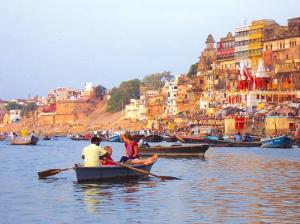September 28, 2015
A trip to Benaras
It is a story about the history of Banaras and places to visit - a semi travelog
A trip to Benaras
by Sharmishtha Shenoy
Banaras or Varanasi as it is known now is one of the oldest living cities in India and in the world. It is a magnificent city as seen from the Ganga at dawn. The rays of the early morning sun strike the high banked face of the city which we, the Hindus call Kashi which means the Luminous, the City of Light.
This temple city is known for being the heartland of Hindu renaissance, the land of piety, philosophy and religious mysticism. For over 2500 years, this city has attracted pilgrims and seekers from all over India. Sages such as Buddha, Mahavira have come here to teach.
Mark Twain on his visit to Banaras quipped,” Banaras is older than history, older than tradition, even older than legend and looks twice as old as all of them put together!”
In India, the very thin line that often separates myth from truth can be seen at best in Varanasi. In this city, live the 330 million gods that are believed to be worshipped. It is logical, therefore, to say that it is even more heavenly than the heavens. It is also said that when Shiva, the god of destruction lets loose the pralaya (the flood that will destroy all creation), Kashi will remain unscathed. It is truly an eternal city!
Bathing in the Ganges, a river said to have fallen from heaven to earth, is the first act of the pilgrims and a daily ritual for the residents. Across the Ganges River there are seventy bathing ghats from Asi Ghat in the south to the Adi Keshava in the north. It would be safe to say that the life of a Hindu centres on the Varanasi ghats. When he is born, he is brought to the ghats for the blessings of the Gods, he receives the holy thread or poyte on its banks and when it is time for him to depart to the other world, his mortal remains are cremated on its banks.
No journey to Varanasi is, hence, complete without a visit to the ghats. One of the most important ghats in Varanasi, Dasahhwamedh derives its name from the ten (dus, in Hindi) horse sacrifices (ashwamedh) performed here by Lord Brahma to appease Lord Shiva. One of the primary attractions is the Ganga aarati. Every evening, priests come down to the ghats and worship the Ganga with multi-tiered flaming lamps. Viewed from a boat on the river, it is a visual spectacle.
No other city on earth is as famous for death as is Banaras. In Kashi life is lived in the perpetual presence of death. More than her temples and magnificent ghats, more than her silk and brocades, Banaras, the Great Cremation Ground, is known for death. At the centre of the city, along the Ganga is the Manikarnika Ghat, the sanctuary of death, with its endless cremation pyres burning day and night. It is believed that Lord Shiva himself goes near the burning pyre and carries the soul to heaven. Fuelled by this belief, the ghat receives hundreds of bodies every day. Kashi is comfortable with the fact of death, for, “Death in Kashi is liberation” – Kashyam maranam muktih. Death, the most natural, unavoidable and certain of human realities, is here the sure gate to moksha, the rarest, most precious, most difficult to achieve spiritual goals.
Also there are dozens of temples with high spires, most of them dedicated to Lord Shiva, who according to tradition makes this city his permanent earthly home. These temples in Varanasi have great religious and historical importance in Hinduism. There are many temples, erected at different times throughout the history of Varanasi. One of the most popular and revered shrines of Varanasi is the Kashi Vishwanath Temple. It is one of the twelve sacred jyotirlingas or the 'lingas of light’. Devotees believe that even a glance of this famed linga can sanctify one’s entire being. In the same complex is the temple of Devi Annapurna Bhavani. Sharing the same complex of Kashi Vishwanath Temple on the Panchganga Ghat is the GyanVapi Mosque. The triple domed Mughal style mosque was built by Emperor Aurangzeb. The mosque and the Kashi Vishwanath Temple stand testimony to the diversity of India. Another important temple is the Durga Mandir. The 18th century temple, placed on the rectangular Durga Kund, can be easily identified by its huge multi-tiered red shikhara. Built by a Bengali queen, the goddess is worshipped with fervour especially during the Navratras. Founded by Goswami Tulsidas, the holy Sankat Mochan Hanuman Temple is believed to grant the wishes and desires of those in distress. According to Vedic Astrology, Lord Hanuman rescues people from the malignant forces of planet Saturn. The New Kashi Vishwanath Mandir is situated within the Banaras Hindu University grounds; the Shiva temple was planned by Madan Mohan Malviya and built by the famous Birla family. The Bhagavad Gita engraved on the walls and Shivalinga are the main attraction of this temple.
Sarnath is a small town barely 12 kms from Varanasi rail junction. Sarnath is one of the most important Buddhist pilgrimage and heritage site. This is where the Lord Buddha delivered his first sermon. Sarnath is home to the excavated remains of the ancient Buddhist monasteries, the famous Lion capital – India’s national emblem, a archaeological museum, huge stupas including the Dhamek and Chaukhandi Stupa and many Buddhist temples built here by missions from Japan, China, Tibet, Cambodia and others. In the Budhist temple of Sarnath there is a beautiful idol of Buddha with some beautiful drawings inside the temple. It is very calm and peaceful there.
Visiting Varanasi
Minimum three days will be needed to see Banaras or Varanasi. Meals can be had at Annapurna Hotel Shakumbari Chauraha, Bhelupur. After sampling the famous Banarasi Pan, visit the Durga Mandir, the Sankat Mochan temple and the Tulsi Manas Mandir. Also visit the nearby Banaras Hindu University. The New Vishwanath Temple is located inside the beautiful campus.
Second day one can go for a boat ride in the Ganges where one can see the various ghats from the boat. Also visit the old Vishwanath temple and perform puja there before going back to hotel for breakfast. Then after breakfast hire a car and visit Sarnath, Ramnagar Fort.
The Ramnagar fort houses a museum displaying the Royal collection which includes vintage Cars, Royal palkies, an armoury of swords and old guns, ivory work and antique clocks. The Durga Temple and Chhinnamastika Temple are also located at Ramnagar. A temple of Dakshin Mukhi Hanuman is there. Inside the giant walls of the Ramnagar fort-palace, there is a big clock. This clock not only displays year, month, week and day but also astronomical facts about the sun, moon and constellation of stars. An interesting array of ornate palanquins, gold-plated howdahs and weapons are some of the artefacts on display in the Ramnagar fort-palace museum. Try to have the Lassi in Ramnagar – it is very famous – even foreigners come here to taste the Lassi. After this go back to the hotel and rest for an hour before going to Dasahhwamedh ghat to see the Ganga Aarati in the evening. On the way back have chaat at the famous Kashi chaat bhandhar.
On the third day, after breakfast go to the famous alleyways of Benares. Visit the Annapurna temple, Vishalakshi temple and Durga Temple. Also visit Manikarnika and Dasahhwamedh Ghats and Kachauri Gali. Finally visit the KalBhairav .
The best season to visit Banaras would be July to March.
Varanasi is the beating heart of the Hindu universe. Most visitors agree it's a magical place, but it's not for the faint-hearted. Here the most intimate rituals of life and death take place in public, and the sights, sounds and smells in and around the ghats – not to mention the almost constant attention from touts – can be overwhelming. Persevere. Varanasi is unique, and a walk along the ghats or a boat ride on the river will live long in the memory.
References : Diana L. Eck - Banaras City of Light
http://www.incredibleindia.org/en/travel/destination/varanasi
This temple city is known for being the heartland of Hindu renaissance, the land of piety, philosophy and religious mysticism. For over 2500 years, this city has attracted pilgrims and seekers from all over India. Sages such as Buddha, Mahavira have come here to teach.
Mark Twain on his visit to Banaras quipped,” Banaras is older than history, older than tradition, even older than legend and looks twice as old as all of them put together!”
In India, the very thin line that often separates myth from truth can be seen at best in Varanasi. In this city, live the 330 million gods that are believed to be worshipped. It is logical, therefore, to say that it is even more heavenly than the heavens. It is also said that when Shiva, the god of destruction lets loose the pralaya (the flood that will destroy all creation), Kashi will remain unscathed. It is truly an eternal city!
Bathing in the Ganges, a river said to have fallen from heaven to earth, is the first act of the pilgrims and a daily ritual for the residents. Across the Ganges River there are seventy bathing ghats from Asi Ghat in the south to the Adi Keshava in the north. It would be safe to say that the life of a Hindu centres on the Varanasi ghats. When he is born, he is brought to the ghats for the blessings of the Gods, he receives the holy thread or poyte on its banks and when it is time for him to depart to the other world, his mortal remains are cremated on its banks.
No journey to Varanasi is, hence, complete without a visit to the ghats. One of the most important ghats in Varanasi, Dasahhwamedh derives its name from the ten (dus, in Hindi) horse sacrifices (ashwamedh) performed here by Lord Brahma to appease Lord Shiva. One of the primary attractions is the Ganga aarati. Every evening, priests come down to the ghats and worship the Ganga with multi-tiered flaming lamps. Viewed from a boat on the river, it is a visual spectacle.
No other city on earth is as famous for death as is Banaras. In Kashi life is lived in the perpetual presence of death. More than her temples and magnificent ghats, more than her silk and brocades, Banaras, the Great Cremation Ground, is known for death. At the centre of the city, along the Ganga is the Manikarnika Ghat, the sanctuary of death, with its endless cremation pyres burning day and night. It is believed that Lord Shiva himself goes near the burning pyre and carries the soul to heaven. Fuelled by this belief, the ghat receives hundreds of bodies every day. Kashi is comfortable with the fact of death, for, “Death in Kashi is liberation” – Kashyam maranam muktih. Death, the most natural, unavoidable and certain of human realities, is here the sure gate to moksha, the rarest, most precious, most difficult to achieve spiritual goals.
Also there are dozens of temples with high spires, most of them dedicated to Lord Shiva, who according to tradition makes this city his permanent earthly home. These temples in Varanasi have great religious and historical importance in Hinduism. There are many temples, erected at different times throughout the history of Varanasi. One of the most popular and revered shrines of Varanasi is the Kashi Vishwanath Temple. It is one of the twelve sacred jyotirlingas or the 'lingas of light’. Devotees believe that even a glance of this famed linga can sanctify one’s entire being. In the same complex is the temple of Devi Annapurna Bhavani. Sharing the same complex of Kashi Vishwanath Temple on the Panchganga Ghat is the GyanVapi Mosque. The triple domed Mughal style mosque was built by Emperor Aurangzeb. The mosque and the Kashi Vishwanath Temple stand testimony to the diversity of India. Another important temple is the Durga Mandir. The 18th century temple, placed on the rectangular Durga Kund, can be easily identified by its huge multi-tiered red shikhara. Built by a Bengali queen, the goddess is worshipped with fervour especially during the Navratras. Founded by Goswami Tulsidas, the holy Sankat Mochan Hanuman Temple is believed to grant the wishes and desires of those in distress. According to Vedic Astrology, Lord Hanuman rescues people from the malignant forces of planet Saturn. The New Kashi Vishwanath Mandir is situated within the Banaras Hindu University grounds; the Shiva temple was planned by Madan Mohan Malviya and built by the famous Birla family. The Bhagavad Gita engraved on the walls and Shivalinga are the main attraction of this temple.
Sarnath is a small town barely 12 kms from Varanasi rail junction. Sarnath is one of the most important Buddhist pilgrimage and heritage site. This is where the Lord Buddha delivered his first sermon. Sarnath is home to the excavated remains of the ancient Buddhist monasteries, the famous Lion capital – India’s national emblem, a archaeological museum, huge stupas including the Dhamek and Chaukhandi Stupa and many Buddhist temples built here by missions from Japan, China, Tibet, Cambodia and others. In the Budhist temple of Sarnath there is a beautiful idol of Buddha with some beautiful drawings inside the temple. It is very calm and peaceful there.
Visiting Varanasi
Minimum three days will be needed to see Banaras or Varanasi. Meals can be had at Annapurna Hotel Shakumbari Chauraha, Bhelupur. After sampling the famous Banarasi Pan, visit the Durga Mandir, the Sankat Mochan temple and the Tulsi Manas Mandir. Also visit the nearby Banaras Hindu University. The New Vishwanath Temple is located inside the beautiful campus.
Second day one can go for a boat ride in the Ganges where one can see the various ghats from the boat. Also visit the old Vishwanath temple and perform puja there before going back to hotel for breakfast. Then after breakfast hire a car and visit Sarnath, Ramnagar Fort.
The Ramnagar fort houses a museum displaying the Royal collection which includes vintage Cars, Royal palkies, an armoury of swords and old guns, ivory work and antique clocks. The Durga Temple and Chhinnamastika Temple are also located at Ramnagar. A temple of Dakshin Mukhi Hanuman is there. Inside the giant walls of the Ramnagar fort-palace, there is a big clock. This clock not only displays year, month, week and day but also astronomical facts about the sun, moon and constellation of stars. An interesting array of ornate palanquins, gold-plated howdahs and weapons are some of the artefacts on display in the Ramnagar fort-palace museum. Try to have the Lassi in Ramnagar – it is very famous – even foreigners come here to taste the Lassi. After this go back to the hotel and rest for an hour before going to Dasahhwamedh ghat to see the Ganga Aarati in the evening. On the way back have chaat at the famous Kashi chaat bhandhar.
On the third day, after breakfast go to the famous alleyways of Benares. Visit the Annapurna temple, Vishalakshi temple and Durga Temple. Also visit Manikarnika and Dasahhwamedh Ghats and Kachauri Gali. Finally visit the KalBhairav .
The best season to visit Banaras would be July to March.
Varanasi is the beating heart of the Hindu universe. Most visitors agree it's a magical place, but it's not for the faint-hearted. Here the most intimate rituals of life and death take place in public, and the sights, sounds and smells in and around the ghats – not to mention the almost constant attention from touts – can be overwhelming. Persevere. Varanasi is unique, and a walk along the ghats or a boat ride on the river will live long in the memory.
References : Diana L. Eck - Banaras City of Light
http://www.incredibleindia.org/en/travel/destination/varanasi
More from Sharmishtha Shenoy
Simon's Story
by Sharmishtha Shenoy
A young man tries to spend a night in a haunted house on halloween day
- Oct, 19 2015
- Horror Paranormal
Happiness
by Sharmishtha Shenoy
Dedicated to all members of this beautiful forum
- Nov, 15 2015
- Non Fiction
Pluto
by Sharmishtha Shenoy
About my dog and his love for christmas
- Dec, 7 2015
- Humor Realistic Fiction
Religion
by Sharmishtha Shenoy
What is religion? Which God should we believe in?
- Nov, 23 2015
- Humor Non Fiction








3 COMMENTS
rekhanshiraghava
September 28, 2015 - 17:45 Sharmishta... Wow... Banaras... Such a beautiful place... Full of spirituality and beauty... And the way you have written made me fall in love with it...Sharmishtha Shenoy
September 28, 2015 - 18:12 Thanks :-)CurtisRoland
November 16, 2017 - 17:36 Wow! I didn't know about this place before! Thanks to your article I'm planning to visit it soon and record something interesting videos for https://youtu.be/TR8wTX4gP1E Thank you so much for your article!